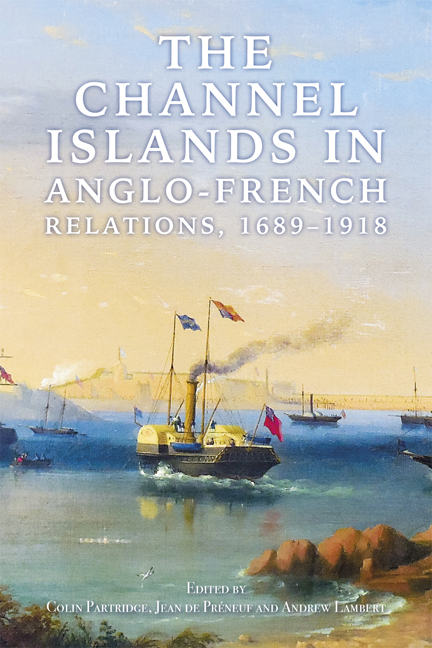Book contents
- Frontmatter
- Dedication
- Contents
- List of Illustrations
- List of Contributors
- Preface
- Introduction: ‘The Ehrenbreitstein of the English Channel’
- Part 1 Corsairs – the Ancien Régime and French Wars from 1689
- Part 2 The Islands – French and British Intelligence from the Seven Years War to 1815
- Part 3 Territorial Waters – the Land and Sea Interface from the 17th to 20th Centuries
- Part 4 Engineering Strategic Change
- Part 5 Alderney and the Channel Islands – Naval Strategy from 1815 to 1905
- Part 6 Civil Societies and Anglo-French Naval Rivalry – the 19th Century to WWI
- Part 7 Trade War – the Protection of Channel Islands Shipping in the Great War
- Afterword: Alderney, The Channel Islands, and the Study of History
- Bibliography
- Index
3 - The Channel Islands in Anglo-French Strategy, 1756−82
Published online by Cambridge University Press: 15 May 2024
- Frontmatter
- Dedication
- Contents
- List of Illustrations
- List of Contributors
- Preface
- Introduction: ‘The Ehrenbreitstein of the English Channel’
- Part 1 Corsairs – the Ancien Régime and French Wars from 1689
- Part 2 The Islands – French and British Intelligence from the Seven Years War to 1815
- Part 3 Territorial Waters – the Land and Sea Interface from the 17th to 20th Centuries
- Part 4 Engineering Strategic Change
- Part 5 Alderney and the Channel Islands – Naval Strategy from 1815 to 1905
- Part 6 Civil Societies and Anglo-French Naval Rivalry – the 19th Century to WWI
- Part 7 Trade War – the Protection of Channel Islands Shipping in the Great War
- Afterword: Alderney, The Channel Islands, and the Study of History
- Bibliography
- Index
Summary
On 7 November 1739, the British declaration of war against Spain was solemnly proclaimed on Guernsey. War had long been expected and the Lieutenant Governor, John Graham, had already been pressing the government for support. He had some success, but this had not reassured the civil authorities. In early November the States ordered Peter Cary, deputy to the States, to explain their concerns to the Secretary of State for the Southern Department, the Duke of Newcastle. From their perspective, Guernsey was hemmed in between St Malo and Cherbourg, so close to the French coast that an invasion force embarked on barques and shallops could be on the island within a few hours. All male inhabitants between the ages of sixteen and sixty, which might amount to 2,000 men, were required to turn out for the militia, but about a third of these men were likely to be employed on privateers. There were only two weak companies of regulars on the island, old soldiers known as invalids, to provide a professional backbone. A proper defence would need at least a regiment and twenty-five field cannon to prevent a landing. However, even this would not be enough. According to Cary, ‘the natural defence of all the Islands’ was effective naval support. If part of the Channel squadron were stationed at Guernsey, which had a good and safe anchorage, it would protect the island from invasion; protect British commerce; destroy French commerce and drive away their privateers. Cary reminded Newcastle of the importance of the Channel Islands. In the last wars with France (1689−98, 1702−13) they had thirty to forty privateers continually cruising along the French coast. Guernsey privateers alone employed 1,700 men (50% of whom were English, Irish and Dutch seamen). They took 1,500 prizes, including many valuable ships. They disrupted French coastal trade, and even penetrated up their rivers. They went where deep-drafted men of war could not venture. They retook prizes from the French and returned them to their owners. They brought frequent and valuable intelligence gleaned from contacts ashore and captured French documents on prizes. For example, Cary claimed that in 1703 intercepted letters, taken on a recaptured English vessel, prevented the 200 ships of the Virginia convoy from falling into the hands of a French squadron that was cruising for them.
- Type
- Chapter
- Information
- The Channel Islands in Anglo-French Relations, 1689-1918 , pp. 53 - 72Publisher: Boydell & BrewerPrint publication year: 2024



